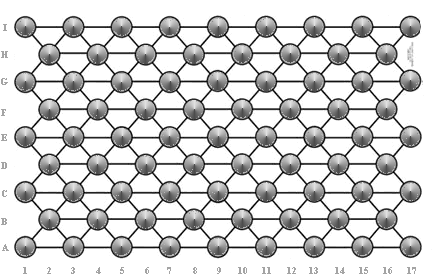|
|
Magyar nyelvu honlap - Hungarian website: http://www.sakk.van.hu ________________________________________________________________________________________________ THE PIECES
Name of piece....Short.....Number of pieces
King...............K........1 White + 1 Black
Queen............Q........2 White + 2 Black
Rook..............R........2 White + 2 Black
Bishop............B........2 White + 2 Black
Knight.............N........2 White + 2 Black
Pawn..............P........8 White + 8 Black
[The short form is used when writing the game.]
THE START POSITION
White pieces: Ka9-Qa7,a11-Ba5,a13-Na3,a15-Ra1,a17
Pb2,b4,b6,b8,b10,b12,b14,b16
Black pieces: Ki9-Qi7,i11-Bi5,i13-Ni3,i15-Ri1,i17
Ph2,h4,h6,h8,h10,h12,h14,h16
HOW THE PIECES MOVE
KING
The King moves one circle at a time in any direction. It can not move to a circle occupied by a piece of the same color. It can not move to a circle under attack by an enemy piece. It takes the undefended enemy piece off the board when moving into its place.
When writing the game, "-" is a plain move [eg. Pb2-c3], "x" is a capture, taking that enemy piece off the board [eg. Ka1xb2].
The King may Castle to either side.
Write the move of Castling left: 0-0-0(L)
Write the move of Castling right: 0-0-0(R)
QUEEN
The Queen can move any numver of circles along a straight line either horizontally or diagonally.
It can not move to a circle occupied by a piece of the same color. It can not jump over any piece(s).
It can move back and forth. It takes the opponent's piece off the board when moving into its place.
ROOK
The Rook can move any number of circles along a horizontal or a diagonal + a horizontal line. It can not move into a circle occupied by a piece of the same color. It takes the opponent's piece off the board when moving into its place. It can not jump over any piece(s).
SINCE THERE ARE NO VERTICAL LINES, THE ROOK ADVANCES OR RETREATS USING THE DIAGONALS.
- WHEN THE ROOK STARTS MOVING ON A HORIZONTAL LINE,
IT MUST STOP ON THAT SAME HORIZONTAL LINE... [IT IS NOT ALLOWED TO TURN ONTO A DIAGONAL]. FOR EXAMPLE: A1-A7 or E13-E3
- WHEN THE ROOK STARTS MOVING ON A DIAGONAL, IT MUST CONTINUE ITS MOVE ON A HORIZONTAL LINE... [IT
CAN NOT STOP ON THE DIAGONAL]. FOR EXAMPLE: A5-(E1)-E9 or A5-(E1)-E17 or A5-(E9)-E1 or A5-(E9)-E7
Other examples:
The Rook is on A5. The A5-E1 diagonal is free of any pieces. There is an enemy piece on E3. In this position, the enemy piece on E3 is under attack by the A5 Rook along A5-(E1)-E3... If the Rook is on E3 and the enemy piece is on A5, the Rook is not attacking the piece along the E3-(E1)-A5 path BUT it is attacking the A5 piece along the E3-(A7)-A5 path.
A PINNED ROOK IS ALLOWED TO TAKE THE PINNING ENEMY PIECE OFF THE BOARD EVEN IF FIRST MOVING OUT ON A DIAGONAL TEMPORARILY EXPOSES THE KING.
KNIGHT
The Knight can not move into a circle occupied by a piece of the same color. It takes the opponent's piece off the board when moving into its place. The Knight is the only piece that can jump.
It may jump over any piece of either color.
It always moves 2 circles at a time, turning at the first circle. In writing, eg. Na7-(b6)-c7 or simply written: Na7-c7.
IT CAN NEVER TURN IN SHARP ANGLES! The following moves, for example, from E5 are not possible: E5-(E3)-D4, E5-(E3)-F4, E5-(D4)-D6, E5-(F4)-F6, E5-(D6)-D4, E5-(F6)-F4, E5-(E7)-D6, E5-(E7)-F6.
The possible moves from E5 are as follows: E5-(E3)-D2, E5-(D4)-D2, E5(-E3)-F2, E5-(F4)-F2, E5-(F4)-E3, E5-(D4)-E3, E5-(F4)-G5, E5-(F6)-G5, E5-(F6)-E7, E5-(D6)-E7, E5-(E7)-F8, E5-(F6)-F8, E5-(E7)-D8, E5-(D6)-D8, E5-(D4)-C5, E5-(D6)-C5.
BISHOP
The Bishop can move back and forth any number of circles straight along a diagonal (it can not turn as part of the same move). It can not jump over any piece(s). It can not move into a circle occupied by a piece of the same color. It takes the opponet's piece off the board when moving into its place.
PAWN
The Pawn can move only diagonally forward. It can never move sideways or backward. It can move 1 or 2 circles from the start position, then only 1 circle at a time. It can not jump over any piece. It can not move into a circle occupied by a piece of the same color. It can capture the opponent's piece (taking it off the board) when the opponent's piece is diagonally ahead of it in the next circle (left or right), that is blocking its way. [No en passant!] When a Pawn advances to the last horizontal file, it has to become a Queen, a Rook, a Bishop or a Knight.
THE GOAL
The Goal is to capture the opponent's King (check-mate).
WINNING
The Winner of the game is who first captures the opponent's King. A player also wins when the opponent's resigns.
DRAW
When there is not enough material to check-mate the opponent's King.
In case of a stale-mate (one of the players can not move).
When the opponents agree to end the game in a Draw.
|
 Image of the Z-Chess board
chess, chess, chess, chess, chess, chess
Image of the Z-Chess board
chess, chess, chess, chess, chess, chess
chess, chess, chess, chess, chess, chess
chess, chess, chess, chess, chess, chess
chess, chess, chess, chess, chess, chess
chess, chess, chess, chess, chess, chess
z-chess, board, games, board, games, online
z-chess, board, games, board, games, online
z-chess, board, games, board, games, online
z-chess, board, games, board, games, online
z-chess, board, games, board, games, online"> |
|
|
|
|
|
|
|

